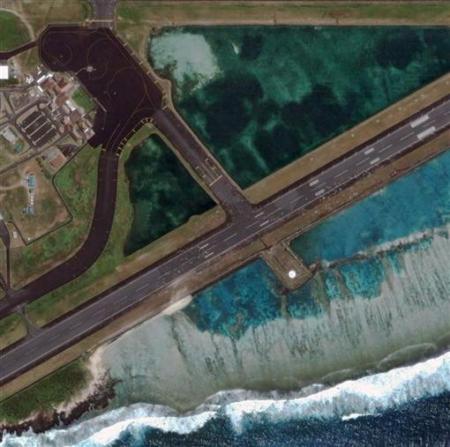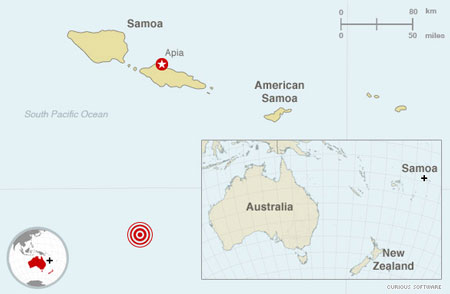A series of natural disasters in 24 hours - Unusual coincidence?
4 tropical storms, 2 strong earthquakes accompanied by tsunamis, all occur around the Western Pacific and South Asia within just 24 hours. So we can relate to each other?
According to meteorologist and weather program producer CNN Brandon Miller, the phenomena are clearly not precedent. ' September represents the culmination of activity in tropical regions around the world. Each year, the Western Pacific itself suffers from more tropical storms than anywhere in the world. That's why it's not uncommon for four storms to hit the area at the same time , 'he remarked.
Perhaps noticeable here are two major earthquakes, an 8.3-degree match near Samoa on September 29, followed by a 7.6-magnitude earthquake in western Indonesia.

Tsunami image entered Tafuna International Airport, capital of Pago Pago, American Samoa, September 29.
The epicenter of these two earthquakes lies 7,600km apart, but the US Geological Survey declined to say whether they were related to each other.
Mr. Miller said: ' We only see an average of 5-10 earthquakes with this kind of intensity globally every year. So the two earthquakes that occurred in the same area within 18 hours seemed quite coincidental . '
The earth is covered by relatively thin tectonic plates, forming the outer shell of the earth - also known as the lithosphere. All these tectonic plates are interlinked and constantly moving, creating pressure along the boundary lines between them.Earthquakes happen when this pressure reaches the peak of danger , like a rubber band when pulled to the limit point will break.
' That seems to be the reason a large earthquake in a location can create the additional force needed for another nearby location, pull the rubber band to the breaking point, causing another earthquake. more, 'explained Miller.

The area has 2 strong earthquakes in 24 consecutive hours.
Another puzzling thing is: Both earthquakes occur along opposite ends of the same tectonic plate, the Australian array . This Australian tectonic border with the Pacific Plate to the east (the Samoa earthquake occurred along this border) while in the west, it was bordered by Asia - Europe.
Many of these tectonic plates surround the Pacific basin, creating an arc of volcanic earthquakes, known as the ' Ring of Fire '. This belt actually has a 40,000 km wide horseshoe shape, where 'gathers' most of the earth's volcanic activity above sea level and most of the world's earthquakes.
So does the Samoa earthquake help boost the earthquake in Indonesia?
' We can't say for sure, but it seems reasonable, ' Miller remarked.
' Scientists will definitely save these things and try to find relationships that can chain them together, with a final goal to one day be able to give warnings to earthquakes. It's deadly like this'.

The number of people killed in two recent Indonesian earthquakes can reach thousands.
The largest earthquake ever measured was a magnitude 9.5 earthquake that occurred in the belt along the Chilean coast. It then created a tsunami that killed about 2,000 people before "emitting" 61 people in Hawaii and 122 in Japan.
In December 2004, at least a 9-magnitude earthquake rocked the northern coast of Sumatra, Indonesia, causing a terrible tsunami in the Indian Ocean, leaving more than 200,000 people in 11 countries. The family died. Its destructive power to Indonesia, Thailand and Sri Lanka is extremely catastrophic.
Meanwhile, the most terrible volcanic eruption in recent history was in Krakatoa, Indonesia in August 1883. It caused tsunamis as high as 40 meters, hitting nearby islands, destroying hundreds of villages, killing tens of thousands of people.
- Can 2015 El Nino cause more natural disasters?
- Japan: The country suffers from many natural disasters and the way to protect people makes the whole world admired
- 2012: Many natural disasters, no disasters
- Talking numbers about the consequences of natural disasters
- Frightened by the unexplainable coincidences in history
- New method to forecast tsunamis
- The most incredible natural phenomena in the world
- More than 220,000 people died from natural disasters in 2008
- 5 most catastrophic natural disasters in human history
- The worst natural disasters in 2015
- The era of super disasters in Asia
- Looking back at the 10 worst natural disasters in American history
 Is the magnetic North Pole shift dangerous to humanity?
Is the magnetic North Pole shift dangerous to humanity? Washington legalizes the recycling of human bodies into fertilizer
Washington legalizes the recycling of human bodies into fertilizer Lightning stone - the mysterious guest
Lightning stone - the mysterious guest Stunned by the mysterious sunset, strange appearance
Stunned by the mysterious sunset, strange appearance